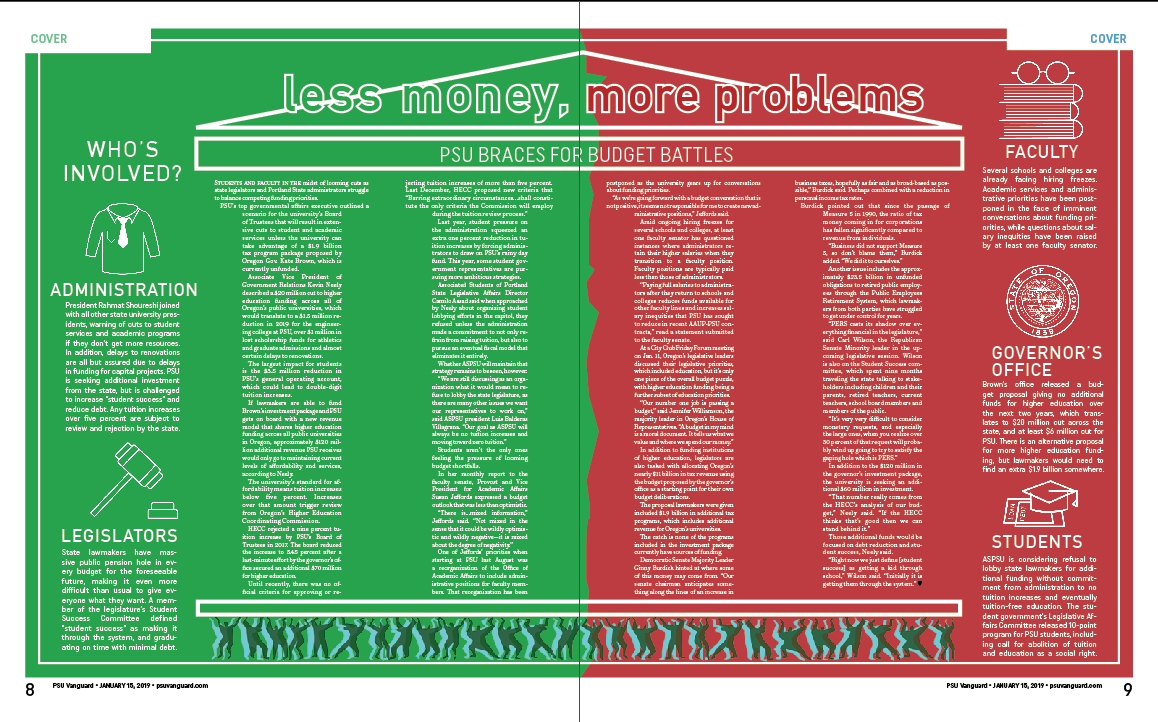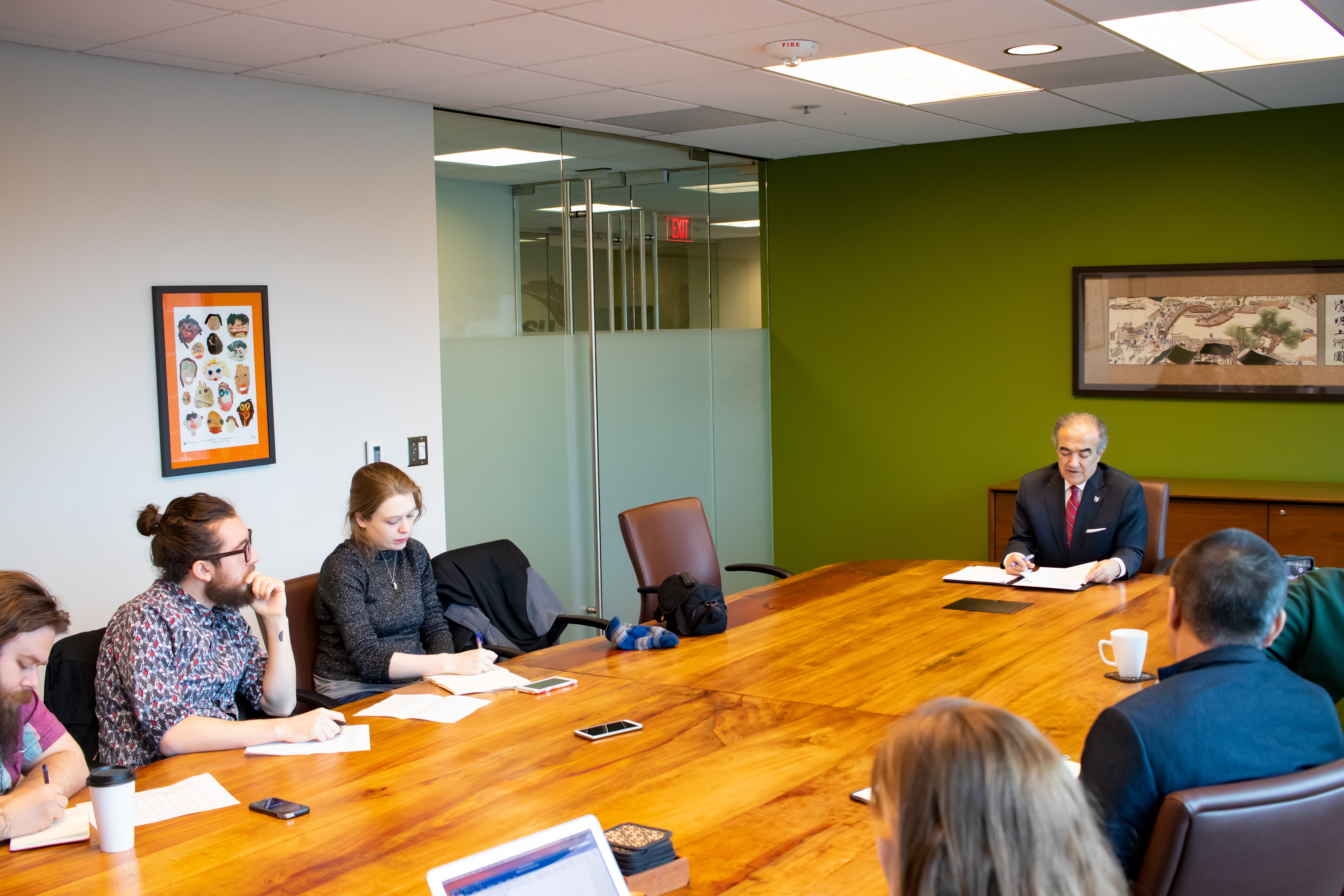Students and faculty in the midst of looming cuts as state legislators and Portland State administrators struggle to balance competing funding priorities.
PSU’s top governmental affairs executive outlined a scenario for the university’s Board of Trustees that will result in extensive cuts to student and academic services unless the university can take advantage of a $1.9 billion tax program package proposed by Oregon Gov. Kate Brown, which is currently unfunded.
Associate Vice President of Government Relations Kevin Neely described a $20 million cut to higher education funding across all of Oregon’s public universities, which would translate to a $1.5 million reduction in 2019 for the engineering college at PSU, over $1 million in lost scholarship funds for athletics and graduate admissions and almost certain delays to renovations.
The largest impact for students is the $3.5 million reduction in PSU’s general operating account, which could lead to double-digit tuition increases.
If lawmakers are able to fund Brown’s investment package and PSU gets on board with a new revenue model that shares higher education funding across all public universities in Oregon, approximately $120 million additional revenue PSU receives would only go to maintaining current levels of affordability and services, according to Neely.
The university’s standard for affordability means tuition increases below five percent. Increases over that amount trigger review from Oregon’s Higher Education Coordinating Commission.
HECC rejected a nine percent tuition increase by PSU’s Board of Trustees in 2017. The board reduced the increase to 5.45 percent after a last-minute effort by the governor’s office secured an additional $70 million for higher education.
Until recently, there was no official criteria for approving or rejecting tuition increases of more than five percent. Last December, HECC proposed new criteria that “Barring extraordinary circumstances…shall constitute the only criteria the Commission will employ during the tuition review process.”
Last year, student pressure on the administration squeezed an extra one percent reduction in tuition increases by forcing administrators to draw on PSU’s rainy day fund. This year, some student government representatives are pursuing more ambitious strategies.
Associated Students of Portland State Legislative Affairs Director Camilo Assad said when approached by Neely about organizing student lobbying efforts in the capitol, they refused unless the administration made a commitment to not only refrain from raising tuition, but also to pursue an eventual fiscal model that eliminates it entirely.
Whether ASPSU will maintain that strategy remains to be seen, however.
“We are still discussing as an organization what it would mean to refuse to lobby the state legislature, as there are many other issues we want our representatives to work on,” said ASPSU president Luis Balderas Villagrana. “Our goal as ASPSU will always be no tuition increases and moving toward zero tuition.”
Students aren’t the only ones feeling the pressure of looming budget shortfalls.
In her monthly report to the faculty senate, Provost and Vice President for Academic Affairs Susan Jeffords expressed a budget outlook that was less than optimistic.
“There is…mixed information,” Jeffords said. “Not mixed in the sense that it could be wildly optimistic and wildly negative—it is mixed about the degree of negativity.”
One of Jeffords’ priorities when starting at PSU last August was a reorganization of the Office of Academic Affairs to include administrative positions for faculty members. That reorganization has been postponed as the university gears up for conversations about funding priorities.
“As we’re going forward with a budget conversation that is not positive, it seems not responsible for me to create new administrative positions,” Jeffords said.
Amid ongoing hiring freezes for several schools and colleges, at least one faculty senator has questioned instances where administrators retain their higher salaries when they transition to a faculty position. Faculty positions are typically paid less than those of administrators.
“Paying full salaries to administrators after they return to schools and colleges reduces funds available for other faculty lines and increases salary inequities that PSU has sought to reduce in recent AAUP-PSU contracts,” read a statement submitted to the faculty senate.
At a City Club Friday Forum meeting on Jan. 11, Oregon’s legislative leaders discussed their legislative priorities, which included education, but it’s only one piece of the overall budget puzzle, with higher education funding being a further subset of education priorities.
“Our number one job is passing a budget,” said Jennifer Williamson, the majority leader in Oregon’s House of Representatives. “A budget in my mind is a moral document. It tells us what we value and where we spend our money.”
In addition to funding institutions of higher education, legislators are also tasked with allocating Oregon’s nearly $11 billion in tax revenue using the budget proposed by the governor’s office as a starting point for their own budget deliberations.
The proposal lawmakers were given included $1.9 billion in additional tax programs, which includes additional revenue for Oregon’s universities.
The catch is none of the programs included in the investment package currently have sources of funding.
Democratic Senate Majority Leader Ginny Burdick hinted at where some of this money may come from. “Our senate chairman anticipates something along the lines of an increase in business taxes, hopefully as fair and as broad-based as possible,” Burdick said. Perhaps combined with a reduction in personal income tax rates.
Burdick pointed out that since the passage of Measure 5 in 1990, the ratio of tax money coming in for corporations has fallen significantly compared to revenue from individuals.
“Business did not support Measure 5, so don’t blame them,” Burdick added. “We did it to ourselves.”
Another issue includes the approximately $23.5 billion in unfunded obligations to retired public employees through the Public Employees Retirement System, which lawmakers from both parties have struggled to get under control for years.
“PERS casts its shadow over everything financial in the legislature,” said Carl Wilson, the Republican Senate Minority leader in the upcoming legislative session. Wilson is also on the Student Success committee, which spent nine months traveling the state talking to stakeholders including children and their parents, retired teachers, current teachers, school board members and members of the public.
“It’s very very difficult to consider monetary requests, and especially the large ones, when you realize over 30 percent of that request will probably wind up going to try to satisfy the gaping hole which is PERS.”
In addition to the $120 million in the governor’s investment package, the university is seeking an additional $60 million in investment.
“That number really comes from the HECC’s analysis of our budget,” Neely said. “If the HECC thinks that’s good then we can stand behind it.”
Those additional funds would be focused on debt reduction and student success, Neely said.
“Right now we just define [student success] as getting a kid through school,” Wilson said. “Initially it is getting them through the system.”
Having been raised by feral pandas in the remote forests of Chengdu, China has always formed a key part of my identity. After my career as a Hong Kong film producer was derailed by tabloid journalists, I knew I had found the work that would become my life’s purpose. I am passionate about journalism because it allows me to step into worlds I would otherwise never know while channeling my curiosity toward serving and informing the community.






